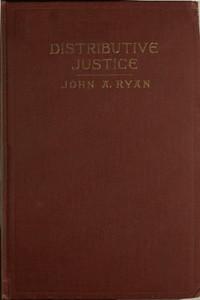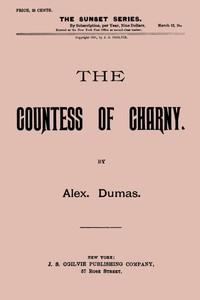Read this ebook for free! No credit card needed, absolutely nothing to pay.
Words: 118436 in 28 pages
This is an ebook sharing website. You can read the uploaded ebooks for free here. No credit cards needed, nothing to pay. If you want to own a digital copy of the ebook, or want to read offline with your favorite ebook-reader, then you can choose to buy and download the ebook.


: Distributive Justice: The Right and Wrong of Our Present Distribution of Wealth by Ryan John A John Augustine - Economic history; Wealth Religious aspects; Income distribution Moral and ethical aspects
forbids this, and gives an exclusive franchise to one company, this legal ordinance, and not any exceptional advantage in the nature of the land occupied, is the specific cause of the monopoly. If the city permits a competing line, and if the two lines sooner or later enter into a combination, the true source and explanation are to be found in the fact of increasing returns. Combination is immeasurably more profitable than cut-throat competition. Moreover, the evils of public service monopolies can be remedied through public control of charges and through taxation. Neither in railroads nor in public utilities is land an impelling cause of monopoly, or a serious hindrance to proper regulation.
Most of Dr. Howe's exaggerations of the influence of land upon monopoly take the form of suggestion rather than of specific and direct statement. When he attempts in precise language to enumerate the leading sources of monopoly, he mentions four; namely, land, railways, the tariff, and public service franchises. Nor is he able to prove his assertion that of these the most important is land.
Nevertheless, land is one of the foremost causes. The most prominent examples of land monopoly in this country are the anthracite coal mines and the iron ore beds. Fully ninety per cent. of our anthracite coal supply is under the control of eight railway systems which in this matter act as a unit. According to Dr. Howe, the excessive profits reaped from this monopolistic control amount to between one hundred and two hundred million dollars annually. In other words, the consumers of anthracite coal must pay every year that much more than they would have expended if the supply had not been monopolised. On the other hand, the formation of monopoly would have been much more difficult if the railroads had been legally forbidden to own coal mines. As things stand, railway monopoly is an important cause of the anthracite coal monopoly. Some authorities are of the opinion that a similar condition of monopoly will ultimately prevail in the bituminous coal mines. Iron ore has been brought under the control of the United States Steel Corporation to such an extent that the Commissioner of Corporations writes: "Indeed, so far as the Steel Corporation's position in the entire iron and steel industry is of a monopolistic character, it is chiefly through its control of ore holdings and the transportation of ore." From this statement, however, it is evident that the monopoly depends upon control of transportation as well as upon ownership of the ore beds. If the former were properly regulated by law, the latter would not be so effective in promoting monopoly.
Speaking generally, we may say that when a great corporation controls a large proportion of the raw material entering into its manufactured products, such control will supplement and reinforce very materially those other special advantages which make for monopoly. Prominent examples are to be found in steel, natural gas, petroleum, and water powers. In his "Report on Water Power Development in the United States," the Commissioner of Corporations declared that the rapidly increasing concentration of control might easily become the nucleus of a monopoly of both steam and water power. Ten great groups of interests, he said, already dominated about sixty per cent. of the developed water power, and were pursuing a policy characterised by a large measure of agreement. As a rough generalisation, it would be fair to say that in one or two instances, at least, landownership is the chief basis, and in several other cases an important contributory cause of monopoly.
Even an approximately accurate estimate of the amount of money which consumers are compelled to pay annually for the products of such concerns over and above what they would pay if the raw material were not wholly or partially monopolised, is obviously impossible. It may possibly run into hundreds of millions of dollars.
The second evil of private landownership to be considered here, is the general fact that it enables some men to take a larger share of the national product than is consistent with the welfare of their neighbours and of society as a whole. As in the matter of monopoly, however, so here, Single Tax advocates are chargeable with a certain amount of overstatement. They contend that the landowner's share of the national product is constantly increasing, that rent advances faster than interest or wages, nay, that all of the annual increase in the national product tends to be gathered in by the landowner, while wages and interest remain stationary, if they do not actually decline.
As a fact, the supply of land is strictly limited by nature, while the other factors can and do increase. There are, however, several forces which neutralise or retard the tendency of land to become scarce, and of rent to rise. Modern methods of transportation, of drainage, and of irrigation have greatly increased the supply of available land, and of commercially profitable land. During the nineteenth century, the transcontinental railroads of the United States made so much of our Western territory accessible that the value and rent of New England lands actually declined; and there are still many millions of acres throughout the country which can be made productive through drainage and irrigation. In the second place, every increase of what is called the "intensive use" of land gives employment to labour and capital which otherwise would have to go upon new land. In America this practice is only in its infancy. With its inevitable growth, both in agriculture and mining, the demand for additional land will be checked, and the rise in land values and rents be correspondingly diminished. Finally, the proportion of capital and labour that is absorbed in the manufacturing, finishing, and distributive operations of modern industry is constantly increasing. These processes call for very little land in comparison with that required for the extractive operations of agriculture and mining. An increase of one-fifth in the amount of capital and labour occupied in growing wheat or in taking out coal, implies a much greater demand for land than the same quantity employed in factories, stores, and railroads.
There are strong indications, however, that the per cent. of the product going to the owners of land has increased considerably in the last twenty years, and that this movement will continue indefinitely. According to Professor King's calculations, the per cent. of the total product assignable as rent advanced from 7.8 in 1900 to 8.8 in 1910, which meant that during that period the national income increased only 70 per cent., while the share of the landowner increased 91 per cent. It is true that a disproportionate advance in rent has occurred between other census years, only to be neutralised by subsequent decreases; but the present instance seems to include certain features which did not characterise any of the former gains in the relative share of the landowner. Since 1896 the prices of food products "rose most rapidly in the case of meat, dairy products, and cereals, which were derived directly from the land. The prices of raw materials show a like relation. Timber, grain, and other raw materials obtained directly from the land have risen rapidly in price, while semi-manufactured articles have increased less rapidly, or have decreased in price.... There is no parallel in any other field to the advance in those land values upon which civilisation most directly depends--timber lands, fertile agricultural land, and land in large commercial and industrial centres. The recent rise in land values has been little short of revolutionary."
The rise in the value of timber lands during the last thirty years has been, in the words of the federal investigators, "enormous." For the ten-year period ending in 1908, "the value of a given piece of southern pine taken at random is likely to have increased in any ratio from three-fold to ten-fold." About the same ratio of increase obtained in the Pacific Northwest, and a somewhat smaller increase in the region of the Great Lakes. While a considerable decline has taken place since 1908, it is only temporary; for the demand for timber is notoriously increasing several times as fast as the supply.
That this upward movement in the value of all three kinds of land will continue without serious interruption, seems to be as nearly certain as any economic proposition that is dependent upon the future. Although millions of acres of arable lands are still unoccupied in the United States and Canada, the far greater part of them require a comparatively large initial outlay for draining, clearing, irrigation, etc., in order to become productive. Hence there is no likelihood that they can be brought under cultivation fast enough to halt or greatly retard the advancing values which follow upon the growth of population and the increased demand for agricultural products. In all probability the greater part of them will not come into use until the prices of farm products have risen above the present level. Obviously this supposes an increase in the value of all farm land, old and new. Nor is the adoption of better methods of farming likely to check seriously the upward movement. Between 1900 and 1910 the urban population of America increased 34.8 per cent., as against a gain of only 21 per cent. in the total population. This disproportionate growth in the number of the city dwellers will if continued make certain what is in any case extremely probable, a steady and considerable advance in urban land values and rents.
In the twenty years between 1890 and 1910, the proportion of farm families in the United States owning farm land, mortgaged or unmortgaged, declined from 65.9 per cent. to 62.8 per cent.; the proportion of urban families owning their homes, encumbered or unencumbered, increased from 36.9 to 38.4 per cent., and the proportion of all families owning homes, encumbered or unencumbered, fell from 47.8 to 45.8 per cent. Of the homes owned by their occupiers, 28 per cent. were mortgaged in 1890, and 32.8 per cent. in 1910. While a decline of two per cent. in the home owning and landowning families in twenty years, and an increase of almost five per cent. in the number of those families who hold their property subject to encumbrance, may not seem very serious in themselves, they indicate a definitely unhealthy trend. Not only are the landowning families in a minority, but the minority is becoming smaller.
Nevertheless, when we consider the amount of gains accruing to the average member of the landowning class, we do not find that it is unreasonably large. The great majority of landed proprietors have not received, nor are they likely to receive, from their holdings incomes sufficiently large to be called excessive shares of the national product. Their gross returns from land have not exceeded the equivalent of fair interest on their actual investment, and fair wages for their labour. The landowners who have been enabled through their holdings to rise above the level of moderate living constitute a comparatively small minority. And these statements are true of both agricultural and urban proprietors.
Free books android app tbrJar TBR JAR Read Free books online gutenberg
More posts by @FreeBooks

: True Tales of Mountain Adventures: For Non-Climbers Young and Old by Le Blond Aubrey Mrs - Mountaineering; Alps Description and travel


: The Countess of Charny; or The Execution of King Louis XVI by Dumas Alexandre Williams Henry Llewellyn Translator - France History Revolution 1789-1799 Fiction; Marie Antoinette Queen consort of Louis XVI King of France 1755-1793 Fiction






